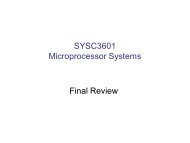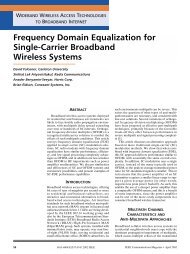Image Reconstruction for 3D Lung Imaging - Department of Systems ...
Image Reconstruction for 3D Lung Imaging - Department of Systems ...
Image Reconstruction for 3D Lung Imaging - Department of Systems ...
Create successful ePaper yourself
Turn your PDF publications into a flip-book with our unique Google optimized e-Paper software.
(a)<br />
RTik<br />
BR=.328,<br />
SNR=.462<br />
(b)<br />
Rdiag<br />
BR=.236,<br />
SNR=.332<br />
(c)<br />
RHPF<br />
BR=.324,<br />
SNR=.440<br />
(d)<br />
RLap<br />
BR=.296,<br />
SNR=.485<br />
Figure 5.4: Comparison <strong>of</strong> 2D Nodal reconstructions using tank data <strong>for</strong> different filters and<br />
Jacobians using 1024 element mesh. <strong>Reconstruction</strong>s are normalized so that the vertical axis<br />
and color scales are maximized.<br />
corresponding elemental solutions; however, this can be compensated <strong>for</strong> through normalization<br />
which is how the solutions <strong>of</strong> figures 5.3 and 5.4 are displayed. Resolution and SNR<br />
are better discriminators between algorithms. The elemental Jacobian algorithm with a<br />
Rdiag prior is the best all around reconstruction in terms <strong>of</strong> resolution. The nodal algorithm<br />
with the Rdiag prior is competitive with its elemental counterpart in terms <strong>of</strong> both<br />
resolution and SNR. Conversion from nodal to elemental basis, as described in section 5.2.4,<br />
imparts additional smoothing to the elemental solutions. This effect is not quantified here,<br />
however the elemental solutions do have the advantage <strong>of</strong> this additional smoothing. The<br />
solutions presented in figures 5.3 and 5.4 are in the elemental basis.<br />
It is possible to improve the signal to noise ratio while maintaining the peak signal<br />
advantage <strong>of</strong> the nodal solutions by applying one or more stages <strong>of</strong> spatial filter discussed<br />
in 5.2.7. As shown in figure 5.5 the results are substantive. Repeated applications <strong>of</strong> the<br />
smoothing filter to the Rdiag solution increase the SNR at the expense <strong>of</strong> peak amplitude<br />
and resolution. One or two passes <strong>of</strong> the filter can improve the SNR by 50% <strong>for</strong> a small<br />
cost in resolution.<br />
The 2D results validate the applicability <strong>of</strong> the Nodal Jacobian algorithms by showing<br />
that <strong>for</strong> the configuration tested here, the nodal algorithm produces reconstructions as good<br />
as the elemental algorithms in terms <strong>of</strong> resolution and SNR. Moreover the nodal algorithms<br />
require less memory and run faster due to the smaller linear system that must be solved.<br />
Although not important <strong>for</strong> 2D reconstructions these speed and memory improvements<br />
allow the solution <strong>of</strong> larger systems inherent to <strong>3D</strong> applications.<br />
5.3.2 Hyperparameter Selection<br />
The BestRes method <strong>of</strong> hyperparameter selection <strong>for</strong> 2D EIT is described in chapter 4.<br />
This method suggests selecting a hyperparameter that results in a reconstruction that has<br />
maximum resolution <strong>for</strong> an impulse contrast. The method was evaluated <strong>for</strong> <strong>3D</strong> as follows.<br />
λBestRes was evaluated as a function <strong>of</strong> radial position at the centre plane. For the Rdiag<br />
prior the curve does not have a narrow minimum (is flat) <strong>for</strong> contrasts near the centre but<br />
becomes stable with a pronounced minimum <strong>for</strong> contrasts located between 20 and 75% <strong>of</strong><br />
the radius from the centre. The curve becomes unstable <strong>for</strong> contrasts located at 85% radial<br />
position (close to the edge). The RTik curve remains flat <strong>for</strong> contrasts located near the<br />
centre and is unreliable until the contrasts are at radial positions between 30 and 65% to<br />
the edge. The resolution curve is very flat <strong>for</strong> the RLap prior but has detectable minimums<br />
that allow selection <strong>of</strong> the hyperparameter when the radial position <strong>of</strong> the target phantom<br />
71





